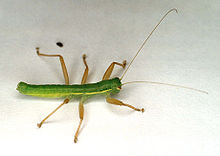Mantophasmatidae
| Gladiators Temporal range: Jurassic - Recent
| |
|---|---|

| |
| Mantophasma zephyrum Zompro et al., 2002 | |
| Scientific classification | |
| Kingdom: | |
| Phylum: | |
| Class: | |
| Subclass: | |
| Infraclass: | |
| Superorder: | |
| Order: | |
| Suborder: | Mantophasmatodea
|
| Family: | Mantophasmatidae
|
| Subfamilies, tribes | |
|
see text | |
Mantophasmatodea is a suborder of carnivorous African insects discovered in 2002, originally considered to be a new order, but since relegated to subordinal status, and comprising the single family Mantophasmatidae. The most common vernacular name for this order is gladiators, although they also are called rock crawlers, heelwalkers, mantophasmids, and coloquially, mantos. Their modern centre of endemism is western South Africa and Namibia (Brandberg Massif[2]), although a relict population, and Eocene fossils suggest a wider ancient distribution.
Members of the order are wingless even as adults, making them relatively difficult to identify. They resemble a mix between praying mantids and phasmids, and molecular evidence indicates that they are most closely related to the equally enigmatic group, Grylloblattodea[1], with which they have now been grouped together in the order Notoptera. The gladiators initially were described from old museum specimens that originally were found in Namibia (Mantophasma zephyrum) and Tanzania (M. subsolanum), and from a 45-million-year-old specimen of Baltic amber (Raptophasma kerneggeri).
Live specimens were found in Namibia by an international expedition in early 2002; Tyrannophasma gladiator was found on the Brandberg Massif, and Mantophasma zephyrum was found on the Erongoberg Massif.[2]
Classification
The most recent classification[3] recognizes numerous genera, including fossils:
- Basal and incertae sedis
- Genus †Raptophasma Zompro, 2001
- Genus †Adicophasma Engel & Grimaldi, 2004
- Genus †Ensiferophasma Zompro, 2005 (may not belong to Mantophasmatodea)
- Subfamily Tanzaniophasmatinae
- Genus Tanzaniophasma Klass, Picker, Damgaard, van Noort, Tojo, 2003
- Subfamily Mantophasmatinae
- Tribe Tyrannophasmatini
- Genus Praedatophasma Zompro & Adis, 2002
- Genus Tyrannophasma Zompro, 2003
- Tribe Mantophasmatini Zompro, Klass, Kristensen, Adis, 2002 (paraphyletic?)
- Genus Mantophasma Zompro, Klass, Kristensen, Adis, 2002
- Genus Sclerophasma Klass, Picker, Damgaard, van Noort, Tojo, 2003
- Tribe Austrophasmatini Klass, Picker, Damgaard, van Noort, Tojo, 2003
- Genus Austrophasma Klass, Picker, Damgaard, van Noort, Tojo, 2003
- Genus Hemilobophasma Klass, Picker, Damgaard, van Noort, Tojo, 2003
- Genus Karoophasma Klass, Picker, Damgaard, van Noort, Tojo, 2003
- Genus Lobatophasma Klass, Picker, Damgaard, van Noort, Tojo, 2003 (formerly Lobophasma)
- At least 3 species of one or more new genera
- Tribe Tyrannophasmatini
Sometimes the subfamilies and tribes are all raised to full family status.
References
- ^ S. L. Cameron, S. C. Barker & M. F. Whiting (2006). "Mitochondrial genomics and the new insect order Mantophasmatodea". Molecular Phylogenetics and Evolution. 38: 274–279. doi:10.1016/j.ympev.2005.09.020.
{{cite journal}}: Unknown parameter|quotes=ignored (help) - ^ Zompro, O., Adis, J., Bragg, P.E., Naskrecki, P., Meakin, K., Wittneben, M. & Saxe, V. (2003) A new genus and species of Mantophasmatidae (Insecta: Mantophasmatodea) from the Brandberg Massif, Namibia, with notes on behaviour. Cimbebasia, 19: 13-24.
- ^ Arillo, A. & M. Engel (2006) Rock Crawlers in Baltic Amber (Notoptera: Mantophasmatodea). American Museum Novitates 3539:1-10[1]
